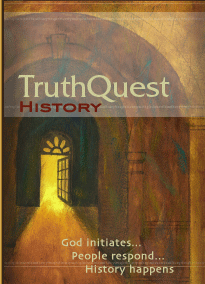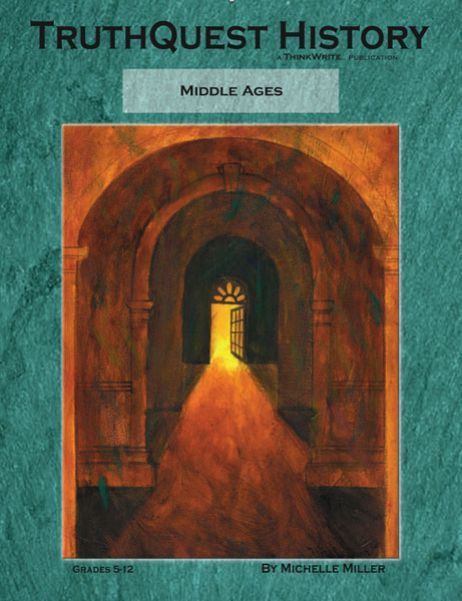
The guide covers history from A.D. 500 to 1400, but as stated on their website, it covers so much more than history.
"You will not learn the story of mankind; you will learn the lovestory of mankind. You will not focus on the rise and fall of human civilizations; you will focus on the arrow-straight line of God’s unchanging existence, power, love, truth, and plan for civilization. You will not simply ‘meet the culture’ or ‘get the facts;’ you will probe the truths of history so deeply that your students will be equipped to change their world!"
TruthQuest Guides are chronological guides that introduce topics and help foster investigative thought about each historical event and era being studied. They are not history spines in and of themselves. Instead the guides introduce a topic for consideration, ask thought-provoking questions, and then recommend resources for reading and learning about each time period and topic to study. These resources include options for spine books and for literature-based studies without spine books. While they are a wonderful resource for organizing history studies and for exploring how faith (and lack thereof) has affected history, I want to stress that the TruthQuest Guides are not history spines.
The Middle Ages guide is written for grades 5-12 and it truly does help students examine historical events in greater depth than your typical spine. It doesn't just give detail, it helps students see God's Hand at work throughout history and mankind's response.
The cost is $24.95 for a printed version and $19.95 for a downloadable PDF. Because of printing costs, you are better off with the printed version. There are no worksheets, so there is no need to make copies of anything.
 A typical lesson includes informal commentary on each topic, followed by recommended reading lists. For those using history spines, chapters are listed. The non-spine recommendations are organized according to age group and range from 2nd through 12th grade. This is very helpful for families that include a wide age-range. Also included are ThinkWrite exercises, peppered throughout the book which offer extra activities, assignments, or food for thought. Suggested answers are included in the appendix. There are 58 lessons in the guide. At 2 lessons per week, you could be finished in 29 weeks. However, older students will have a hard time fitting the suggested reading for 2 lessons into one week.
A typical lesson includes informal commentary on each topic, followed by recommended reading lists. For those using history spines, chapters are listed. The non-spine recommendations are organized according to age group and range from 2nd through 12th grade. This is very helpful for families that include a wide age-range. Also included are ThinkWrite exercises, peppered throughout the book which offer extra activities, assignments, or food for thought. Suggested answers are included in the appendix. There are 58 lessons in the guide. At 2 lessons per week, you could be finished in 29 weeks. However, older students will have a hard time fitting the suggested reading for 2 lessons into one week.A few important considerations:
1. Informal commentary.
No, I mean really informal. The meat of the discussion is beautiful and meaty, but it is presented with a very casual conversational style. Sentences randomly begin with the word "anyway" and the text includes lots of dashes--I mean a lot of dashes. And, while my family finds history incredibly exciting, I have never seen so many exclamation points in a history text before.
Some examples:
"So get this picture in your mind: the further-out barbarians were pressing deeper into Europe, ever Rome-ward. The squeeze was on, and people (ancestors to most of us) were getting shuffled! It was a time of great stirring after centuries of fairly static Roman rule. Interesting! Wouldn't you like to be a mouse in the corner when heavenly decisions were made regarding all these things...not that I know what those decisions were, mind you!"
"Okay, I'm done talking. (Hey, you don't have to look that excited!) Instead, I want you to meet some great folks of the church."
"The death of a Frankish king was a disaster, but not because he had been a teddy bear. Hardly! It was because Frankish custom split a king's land among his sons. These sons-do I sense a little ungratefulness here?-then fought to the death to get their brothers' shares! Things got might messy! But one situation tops them all: two Frankish kings each married a Visigothic princess of Spain because each king wanted the neighboring Visigoths to support their wars. But the two princesses were sisters! Whoo-whee! A terrific feud was set off!"
The title for ThinkWrite 3 is "What'chya believe?" While it is hard to take something so informal very seriously, the heart of the assignment is quite serious and admirable. Students are instructed to write a paragraph describing the Teutons' belief system and to "be on the lookout for their beliefs about personal freedom." They are also instructed to give a hypothesis about what type of behavior you might see from people who held these beliefs.
For reading, the informal tone was silly and awkward. But for reading aloud, it was enjoyable for the kids. While it will never be my favorite to read, I would actually quite enjoy this material if it were on an audio CD.
2. Resource Availability
In section 2's resource list, I could only find 3 out of 19 suggested books in my library system. This was worrisome because I have an absolutely incredible library. If my library doesn't have them, I find it doubtful that very many would. Also cause for concern was the comment "I've heard this is amazingly detailed and offers excellent drawings", which was written under the book title Dark Age Warrior, by Ewart Oakeshott. This makes me wonder how much research was given to the books being recommended.
Despite these negative observations, I do appreciate the heart of the material and we've found it worth overlooking. I will continue to use these guides with our history studies. But I won't read "whoo-whee" out loud unless I'm being paid.
In addition to the guides, you can also purchase support materials such as guides for lapbooks, notebooking, and maps and timelines. TruthQuest's website shares samples of the material so that you can better decide if it is a good fit for you. They also have a variety of layouts to help you decide where to start so that the material can most comfortably fit your family's needs.
There are 11 guides available and you can find reviews for them at The Old Schoolhouse Magazine's TOS Crew.
Disclaimer: I received this material in exchange for my honest opinion as a member of the TOS Crew, and received no other form of compensation. For whatever they're worth, the opinions are mine and mine alone, as stated in my disclosure policy.


1 comment:
Sounds like a great way to discover history!!!
God bless and have an extraordinary week sweetie!!! :o)
Post a Comment